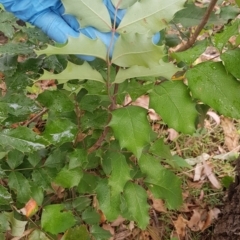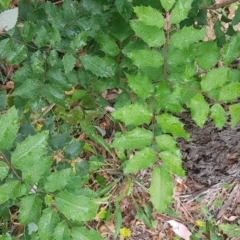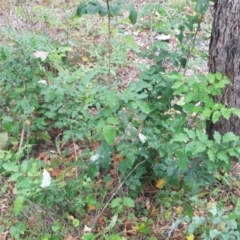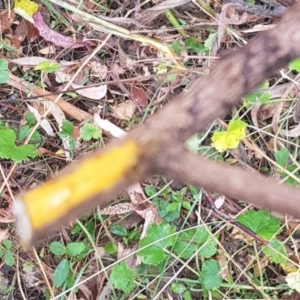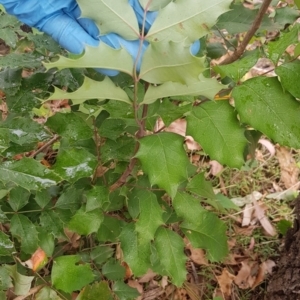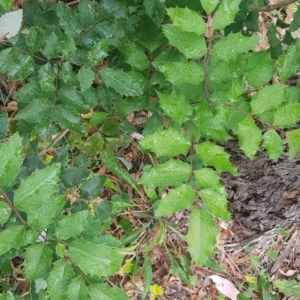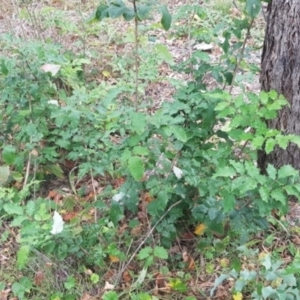Oregon Grape at Mount Majura
Identification history
| Berberis aquifolium | 17 Mar 2024 | waltraud | ||
| Berberis aquifolium | 17 Mar 2024 | MAX |
Identify this sighting
Please Login or Register to identify this sighting.
User's notes
A group of these Juvenile shrubs in about a 5 sq m area, Yellow box grassy woodland habitat , Distinctive Holly like Leaves around 10cm long + Bright yellow sub-bark (Cambial) layer. Probably the 1st sighting ( ?) Of this Woody weed species for Mt Majura. Treated with Cut n Dab to nip this population in the bud. Can be mapped as a " Treated Woody Weed" species. Most likely spread here in bird droppings. ID. Thanks to BARB. 🙂
5 comments
waltraud
wrote:
17 Mar 2024
Max, can you map them please? certainly not the first sighting on Mt Majura - I treated 1000s in the reserve behind Mackenzie street that was before CNM and Field Maps, along Casuarina trail, in the paddock northeast of the watertank; there is still a large crop east of the summit which I always hoped to tackle: Berberis aquifolium (Oregon Grape)
But I can't get up to the summit anymore...
But I can't get up to the summit anymore...
MAX
wrote:
17 Mar 2024
Hi W, I'd suggest there's no further need to "map" this group, as this CNM sighting is already Integrated into the Fieldmaps database.
waltraud
wrote:
18 Mar 2024
Thanks Max. There is certainly a need to (continue to) map this group i.e. Berberis aquifolia whether treated or untreated. I prefer mapping with Field Maps / Treated Weeds; the CNM record is great and a good tool for people who can't map with Field Maps. However, I'm afraid not everyone will check the CNM layer on the Field Maps app - Marty learned yesterday about this CNM layer. I assume when PCS employs a contractor to treat weeds they will tell them to check the CNM layer in addition to Field Maps but I'm not sure...
MAX
wrote:
18 Mar 2024
OK, I get your point... However the Field Maps people need to have a Rethink perhaps about having the CNM data as a Separate layer ? This is not truly integrating all the Mapped Data for Optimum visibility and access, ie. an Overall view of the (weed) species, at a glance, so to speak. I. T. wise not sure what's possible in this regard ? 🙃
waltraud
wrote:
18 Mar 2024
hi Max
the CNM data ARE on a separate layer which can be clicked on and off but you need to have the correct Map: in Field Maps go to Invasive Plants (which contains 25 Maps); then go to the map NOT-TREATED WEEDS (all capital letters); once you are in this map go to the Layer icon in the middle of the top bar; the icon should have a point in the lowest layer shown on this Icon; click on the Icon; scroll down the layers to "NatureMapr Invasive Plants CNM" and click it on; red diamonds appear on your map: these are all CNM records of invasive plants; click on one diamond and it will open the CNM record that is represented by the diamond. If you are interested to adopt the tool I suggest to put a time aside for a practice session.
the CNM data ARE on a separate layer which can be clicked on and off but you need to have the correct Map: in Field Maps go to Invasive Plants (which contains 25 Maps); then go to the map NOT-TREATED WEEDS (all capital letters); once you are in this map go to the Layer icon in the middle of the top bar; the icon should have a point in the lowest layer shown on this Icon; click on the Icon; scroll down the layers to "NatureMapr Invasive Plants CNM" and click it on; red diamonds appear on your map: these are all CNM records of invasive plants; click on one diamond and it will open the CNM record that is represented by the diamond. If you are interested to adopt the tool I suggest to put a time aside for a practice session.
Please Login or Register to comment.
Nearby sightings
Location information
- Coordinates 149.174976-35.231717
- Maps Mount Majura
- Places Watson, ACT
Sighting information
- 25 Abundance
- 17 Mar 2024 11:08 AM Recorded on
- MAX Recorded by
Additional information
- 30cm to 1 metre Plant height
Species information
- Berberis aquifolium Scientific name
- Oregon Grape Common name
- Not Sensitive
- Exotic
- Medium Weed or Pest
- Up to 1112.8m Recorded at altitude
- Machine learning
-
In flower
- External link More information
-
Synonyms
Mahonia aquifolium
Record quality
- Images or audio
- More than one media file
- Confirmed by an expert moderator
- Nearby sighting(s) of same species
- GPS evidence of location
- Description
- Additional attributes

